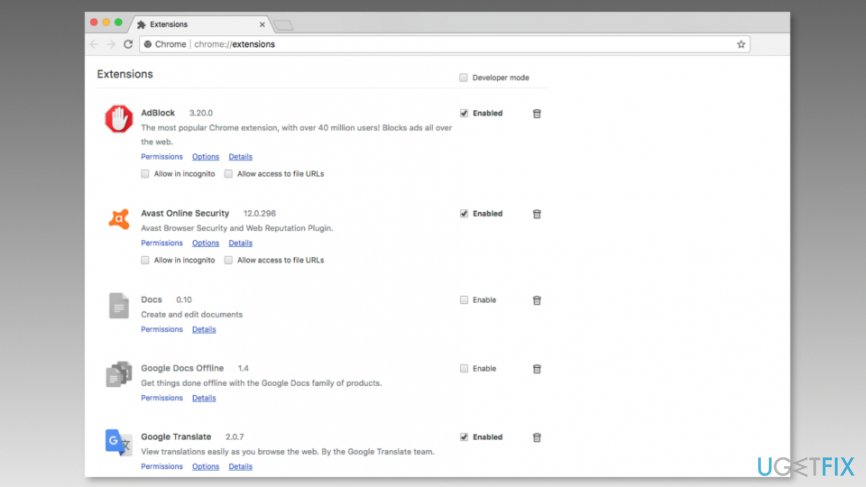To get started, launch App Cleaner, switch to the Extensions tab, and then select the Web Browser Extensions section. Here you can view all your browser extensions, their service files, and where they are stored on your disk. Just select the unneeded ones and click the Remove button to get rid of them. Open Google Chrome and click the ' Chrome menu ' (three horizontal lines) button located in the top-right corner of the browser window. From the drop-down menu, choose ' More Tools ' and select ' Extensions '. In the ' Extensions ' window, look for any recently-installed suspicious add-ons. When located, click the ' Trash ' button next to it/them. Uninstall Adware Extensions Remove Unwanted Device Profiles. Scan Your Mac With VirusBarrier to Remove Adware and Pop-Ups. The best course of action if your Mac is infected with adware is to scan it with an antivirus solution to delete all malicious files from your device.
Open Extensions preferences in System Preferences. That is if you mean Yosemite extensions. Otherwise, use any uninstaller provided by the developer or read the following:
Uninstalling Software: The Basics
Most OS X applications are completely self-contained 'packages' that can be uninstalled by simply dragging the application to the Trash. Applications may create preference files that are stored in the /Home/Library/Preferences/ folder. Although they do nothing once you delete the associated application, they do take up some disk space. If you want you can look for them in the above location and delete them, too.
Some applications may install an uninstaller program that can be used to remove the application. In some cases the uninstaller may be part of the application's installer, and is invoked by clicking on a Customize button that will appear during the install process.
Some applications may install components in the /Home/Library/Applications Support/ folder. 4videosoft video converter ultimate 9 1 26 download free. You can also check there to see if the application has created a folder. You can also delete the folder that's in the Applications Support folder. Again, they don't do anything but take up disk space once the application is trashed.
Some applications may install a startupitem or a Log In item. Startupitems are usually installed in the /Library/StartupItems/ folder and less often in the /Home/Library/StartupItems/ folder. Log In Items are set in the Accounts preferences. Open System Preferences, click on the Accounts icon, then click on the LogIn Items tab. Locate the item in the list for the application you want to remove and click on the '-' button to delete it from the list.
Some software use startup daemons or agents that are a new feature of the OS. Look for them in /Library/LaunchAgents/ and /Library/LaunchDaemons/ or in /Home/Library/LaunchAgents/.
How To Get Rid Of Add OnsIf an application installs any other files the best way to track them down is to do a Finder search using the application name or the developer name as the search term. Unfortunately Spotlight will not look in certain folders by default. You can modify Spotlight's behavior or use a third-party search utility, EasyFind, instead.

Some applications install a receipt in the /Library/Receipts/ folder. Usually with the same name as the program or the developer. The item generally has a '.pkg' extension. Be sure you also delete this item as some programs use it to determine if it's already installed.
There are many utilities that can uninstall applications. Here is a selection:
1. AppZapper
2. AppDelete
3. Automaton

Some applications install a receipt in the /Library/Receipts/ folder. Usually with the same name as the program or the developer. The item generally has a '.pkg' extension. Be sure you also delete this item as some programs use it to determine if it's already installed.
There are many utilities that can uninstall applications. Here is a selection:
1. AppZapper
2. AppDelete
3. Automaton
4. Datebook 1 0 6 – journal articles. Hazel
5. AppCleaner
How To Get Rid Of Stuff Fast6. CleanApp
7. iTrash Goldfish slot game.
8. Amnesia
9.Uninstaller
10.Spring Cleaning
For more information visit The XLab FAQs and read the FAQ on removing software.
How To Uninstall Extensions MacOct 25, 2014 10:26 AM
This is new behavior (circa OS X 10.3):
I often drag URLs from Safari's Address Bar to the desktop to create clickable webloc files. And in the past, they were named automaticall -- with the '.webloc' extension *hidden*.
But now -- even though I have 'Show All Finder extensions' UNchecked in the Finder's preferences -- those files always have the annoying '.webloc' extension *visible*!
I guess my thread title is somewhat misleading; I can, in fact, hide the extension by selecting Get Info and manually checking the 'Hide extension' box -- but that's a PITA to have to do, every time I create one of these files!!! Why can't it just work the way it used to -- with the extension hidden by default?
Is this a new 'feature' in the OS, or a bug, or what?
